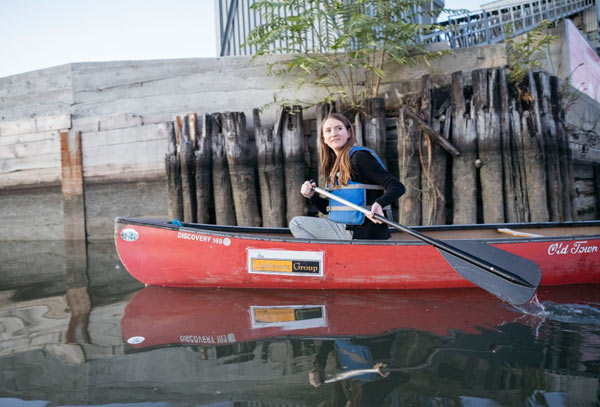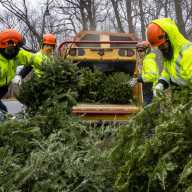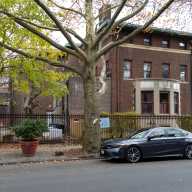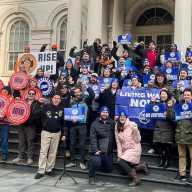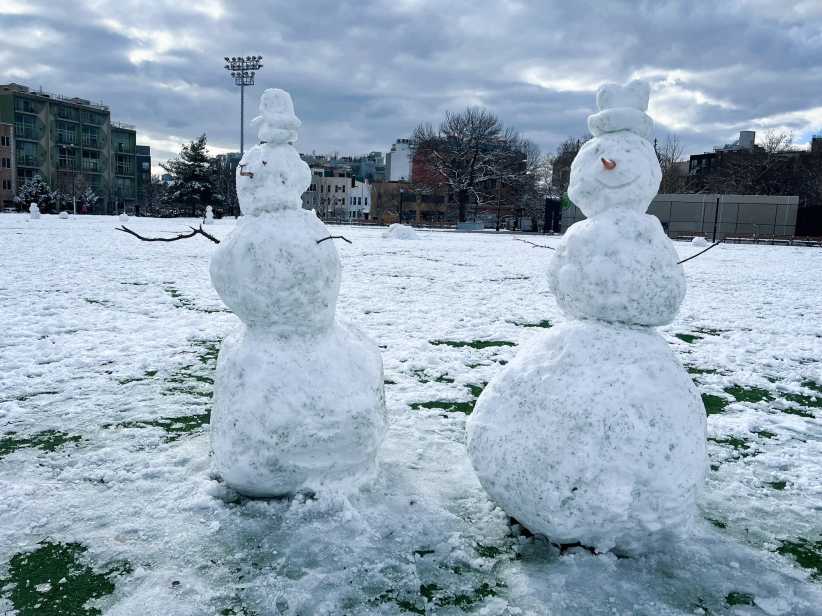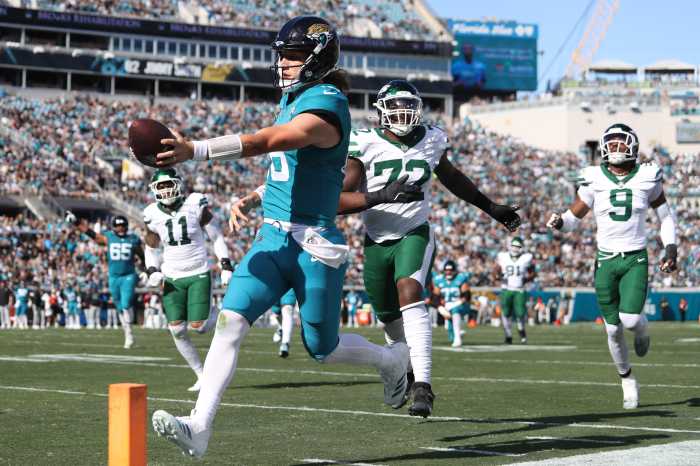I’ve covered Gowanus for nearly two years and written countless stories about its namesake canal. But I always opted to observe its toxic waters from a safe distance, high above on esplanades and bridges. That was until a founder of the Gowanus Dredgers, a canoe club that educates people about the waterway by offering free boating tours, invited me to set sail on the sludgy span. As someone who believes the best way to learn about any subject is by immersing myself in it, I decided to step into a canoe and literally do just that.
The Gowanus Canal is a Superfund site, meaning it is so contaminated that the federal government stepped in to clean it up. Polluters recklessly poured heavy metals, pesticides, and oil into the channel, and raw sewage gushes into it during storms because the city’s infrastructure can’t handle all of the water passing through it. Needless to say, it’s not a the first destination one thinks of for a boat ride.
At around 6 pm on Friday, I arrived at the Dredgers’ boathouse on Bond and Second streets, which is located inside the 365 Bond luxury-apartment complex built by the developer, Lightstone Group. This is the same developer that markets its swanky digs with photos of 20-somethings dangling their feet over the Gowanus Canal’s fetid water and that publishes its own newspaper, The Gowilla, which ran an article last year declaring the neighborhood the “Venice of Brooklyn.” It was not satire.
I met Owen Foote, one of the original Dredgers and an expert on the canal who would be leading my expedition, upon entering the boathouse. I then strapped on a life vest and signed a waiver before hopping into a canoe with Susan, a Sunset Parker who read about the excursions in a recent New York Times article on the changing nabe. She told me she planned to come with her boyfriend, but he changed his mind when he found out the trip would be along one of the nation’s most polluted waterways.
My photographer colleague, Stefano, boarded a boat with Foote, and three other women also eager for an evening on the waterway piled into a third vessel. Once I hit the water, I practiced my paddling technique to ensure I kept my oar flat to avoid splashing my boat-mate. As I concentrated on keeping the sludgy water in the canal and out of my canoe, I looked up and saw graffiti proclaiming “Welcome to Venice jerko” scrawled overheard.
We started our journey toward the Gowanus Bay as the sun began to set, turning the sky beyond the surrounding industrial complexes and Third Street Bridge an idyllic tangerine. People gathered on the span to snap pictures of our unlikely armada as we floated by — making me feel like some sort of celebrity of the toxic abyss — and some jokesters warned, “Don’t fall in!”
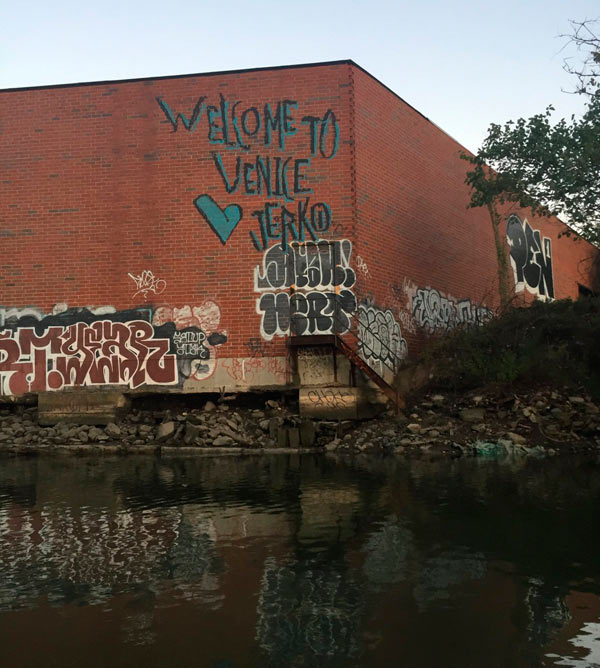
Although I noticed a faint smell of oil, I didn’t find the odor particularly strong. And because it hadn’t rained in awhile, there wasn’t a lot of raw sewage in the water, so my nostrils were thankfully spared from the stench of human waste. But Stefano claimed the water stunk after our ride, so either I have a poor sense of smell or the Gowanus just can’t shake its stinky reputation.
As we sailed forward, Foote recounted the canal’s history. Dutch settlers created it in the 1600s, and soon after, the channel became known for the large oysters that thrived in its brackish waters. Today, wildlife is returning to the canal, he said, as cleanup efforts allow for more oxygen in the waterway. Foote alerted us to small bait fish jumping into the air nearby, but I didn’t catch a glimpse of any myself.
We passed Whole Foods and I spotted oil slicks on the surface of the water that were so pronounced, their iridescent swirls almost looked like a beautiful, sad art installation in the fading light. I later asked Foote about the slicks and he said they were the first he had seen in three weeks, probably the result of someone illegally dumping waste into the water.
“I’m alarmed they were there,” he said.
After traversing beneath the Ninth Street Bridge, we soon encountered Lowe’s, a particular hotspot for Gowanus enthusiasts. The home-improvement store sits on a lot where bulkheads lining the side of the canal collapsed into it in May and July as a result of crumbling infrastructure and bad weather.
The sun was disappearing from the sky at this point, so we turned around and made our way back to shore as Foote spoke about how the canal is being cleaned through the Environmental Protection Agency’s Superfund program and what people can do to help. He advised not to take showers when it rains, in order to decrease the amount of raw sewage that floods the channel — a strategy he said his teenage daughters understandably loathe.

Minutes later, I scrambled onto solid ground after we arrived back at the dock. I survived my first cruise on the Gowanus, but it would not be my last.
I returned for a second ride the next day, this time with my friend, Claire, a Manhattanite who wanted to see the canal herself after hearing about my tour. We forewent a sunset cruise and set sail at around 2:15 pm, with the unseasonably strong October sun providing us a different — and bright! — perspective of the waterway.
In the light of day, I noticed more artifacts in the channel than I had the night before, including a tampon, bottles, cans, small pieces of poo, and plastic wrappers. But no stories about the water being infected with gonorrhea, or being mobsters’ favorite place to dump bodies, or killing a wayward dolphin and whale that swam into it could prepare us for the tragic sight we floated upon after passing the new Hamilton Avenue Waste Transfer Station: a dead cat!
Yes, a furry black feline with all four paws out bobbed past us in the water. We screamed, and paddled away as fast as our arms could propel us. The Gowanus had truly earned its nickname of Brooklyn’s Nautical Purgatory.
Claire and I were both shaken by the incident, but did our best to trek on, snapping photos as we cruised back to the dock and passing the Gowanus’ flushing tunnel — a waterfall-like mechanism that floods the span with clean water — spitting in the distance.
Activists hope that the canal will be an oasis for humans and living wildlife — not just creatures’ dead bodies — after it is cleaned and investments are made to make it an appealing, and safe, destination. But the Environmental Protection Agency still strongly urges people not to swim in the water, although the amount of poo floating in it has decreased in recent years, according to data.

The polluters who tainted the canal certainly gave people many reasons to fear the idea of humans leisurely skimming it as a weekend activity. But I don’t think I fully understood what it is, and what it could be, until I wandered its waters myself. And I hope that, in time, more people will take the plunge, making life on the canal less of a novelty and more of a norm.


